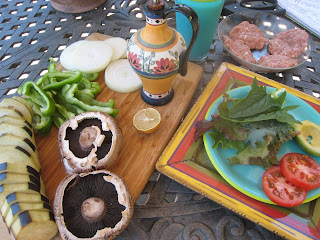
This recipe comes from Cook's Illustrated 2002 book. Yes, book. I have every Cook's Illustrated Magazine published, but not as magazines. I wait till the end of each year's bound editions come out. It's easier this way. They are all indexed, thus easier to find things.
I mentioned in my old blog about packing up all my many cookbooks, and they were boxed for a year. We redid our great-room space and the wall of cookbook shelves came out. I also, with Google's ease in finding things, wanted to see if I missed my books. Like when I got my sourdough starter going again I wanted a sourdough pancake recipe. I Googled it and the recipe in my boxed cookbook was the first recipe to come up! BUT my Cook's Illustrated bound books, back to 1993, amongst a few other books, I did not pack up.
I consult Cook's Illustrated and my Rodale Press cookbooks all the time. I still alter the recipes often, but not this fish one. Growing up, I disliked fish. Monte changed that. He's the best fish cooker. We have a favorite fishing stream we'd take kids, cuz just about every cast caught fish. They're mountain trout - not big. But we'd have enough for a meal every time. My step-dad gives us extra fish too. One year Monte and a friend got some whoppers - they were probably pike. We froze one whole and he just kept sawing slices to cook for a meal, till he got to the head and made a fish broth/soup. In Wisconsin Monte goes for walleye, pike and bass (he's going to probably read this and tell me more). And then I pick up wild salmon often.
Cook's Illustrated solved my dislike for halibut. Rarely have I had good halibut (not that I tried it alot). It's a lean fish, so is usually too dry for my taste. This recipe works every time!
PAN-ROASTED HALIBUT
2Tb olive oil
2 Halibut steaks about 1 1/4" thick
(Locally, we don't have a fish market and so far, the best halibut I've found is at Costco. I never buy farmed fish. With all my bought fish, I put salt and sugar in a container, stirring to dilute it with some warm water, add some milk, put the fish in, add water to cover, and let it soak at least 30 minutes. Rinse and cook.)
Preheat oven to 425 degrees with the rack in the middle position. When the oven reaches 425, in a heavy ovenproof skillet that holds the size of fish, heat on high until the oil just begins to smoke.
Sprinkly the fish with salt and pepper. Reduce heat to med-high, swirl pan to distribute the oil, and carefully put in fish to sear without moving them, until spotty brown - about 4 minutes. Off heat flip fish and transfer the pan to the oven. Roast until 140 degrees, flakes when forked - about 9 minutes. I just put my timer on for 9 minutes, cuz it's just the right time every time. These times, of course, are for the certain thickness. Serve immediately with dollop of a flavored butter.
Flavored Butters
I've tried 2 of the suggested 3 and like them both- chipotle or anchovy.
Both use 4 Tb butter, a minced garlic clove, and 1/2 tsp salt (which I used only a pinch of)
The chipotle uses 1 chipotle chile en adobo (once I open a can, I store it in a jar in the refrigerator so I always have it on hand), seeded and minced with 1 tsp of the adobo.
1 tsp honey
1 tsp lime zest
2 tsp minced fresh cilantro
The anchovy one uses one anchovy, minced to a paste (I get anchovies in a little jar I store in the refrigerator)
1 1/2 tsp lemon juice
2 Tb minced fresh parsley
I use less butter, softening it in the microwave a bit, mixing everything.
The 3rd suggestion is not a butter but a cherry tomato-basil vinaigrette I'll have to try.
Speaking of fish, a magazine article spoke about the seafood choices we should be making. Large fish-eating fish like shark and tuna are the most contaminated fish. Tho "troll or pole-caught" in the US or British Columbia albacore tuna is considered an ok green fish. Why? Where caught and size are keys. Alaskan waters are very well managed, and northern Pacific is the choice over the Atlantic. The fish they say we should be eating every week? The humble sardine! It's naturally packed with more omega-3s and vitamin D than just about any other food.
Smaller fish are lower on the food chain, abundant, and fast-reproducing. Thus there's less build up of contaminants and less fishing pressure. Many fish in the herring family are commonly called sardines. We'll open a tin of sardines or herring quite often for a meal. They're great on crackers, bread, and with salads.
Try mixing
SMOKED SARDINES with some mint. Toast some bread or baguette slices and serve the sardine mixture on the bread along with a slice of tomato. Maybe some thin sliced onion or some chives.
There's many sites for checking on best fish choices, and apps for phones. Look for Seafood Watch, and The Blue Ocean Institute, and go to eatingwell.com/go/fish.
My cookbooks are unboxed now. Monte built shelves in the garage over the freezers. Tho I still get recipes off the internet, I do like having access to my many cookbooks.




































